Beef dripping made the traditional way
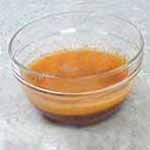
Beef dripping is the fat that drips from a joint of beef during roasting once it has cooled and solidified. Although the meat was traditionally beef and it certainly does give a better flavour, dripping can be made from other meats. Beef dripping used to be the basis of numerous tasty meals with that great old-fashioned taste – and it still can be, because this page explains how to make it with the traditional taste - but adapted for modern labour-saving methods.
____
By the webmaster, based on watching older people cook, informal interviews and years of practice
What is dripping?
Dripping is the fat that drips from a joint during roasting and has solidified.
Before battery chickens and imported lamb became commonplace, dripping was effectively only ever from beef. It gained its popularity because families traditionally had a large joint of roast beef every Sunday. Today, the terms 'beef dripping' and 'dripping' tend to be used interchangeably. Strictly speaking, though, dripping can be made from any fatty meat.
Beef dripping was and still is regarded as the best tasting of all the drippings.
In the past, there was plenty of it because the Sunday joint of beef was large to feed the large families.
Why make dripping today
Dripping used to feature in the preparation of most old savoury recipes. It has a wonderful flavour that no amount of herbs, spices or stock cubes can emulate. It is perfect for frying meat, roasting vegetables and for adding flavour to cooked dishes.
Bread and dripping
In times gone by dripping was a staple meal for children, spread on bread, and it is sad that few children of today have ever sampled 'bread and dripping'.
Shop-bought dripping
Shop-bought beef dripping is not the same, and I would even go as far as to say that it is unpleasant. I have tried it on several occasions when I have run out of my own dripping. I suspect that modern extraction methods have gone too far in what they extract, but of course I can't be sure.
So home-made dripping is well-worth making today.
How dripping used to be made
My method for making dripping is a more convenient adaptation of how dripping was made in the past. Then, dripping was simply made by pouring the hot fat left over from the roasting pan into a heatproof glazed china (ceramic) basin, covering it to keep out flies and dust and leaving it to cool and solidify. The basin was then stored in the food safe.
Once solidified, any dirty bits of charred meat always sunk to the bottom of the basin and were dug out or scraped off and thrown away. Alternatively the rendered fat was 'clarified' - see below.
Why traditional methods are no longer feasible
It is no longer feasible to make much dripping the traditional way. Few of us have large joints of roast beef every week, farmed animals have been bred to be as lean as possible, and today's roast meals are more often made with poultry than beef.
Shortcuts: how to make beef dripping today
The fatty meat
Although large supermarkets tell me that they are no longer have specifically fatty joints of beef, traditional butchers will advise on the fattier parts of beef for roasting and even sell off-cuts of beef fat.
Also, you can make your own fatty off-cuts from whatever meats are to hand. I make my own off-cuts by trimming off the fatty bits off the likes of braising steak, ham, lamb chops and pork joints, etc which would otherwise be left uneaten on people's plates. (Not entirely beef, you will notice, but they still work well with beef. Incidentally, as lamb is widely bought for roasts today, people do make lamb dripping, just from lamb. In my view it is rather too rich.)
It is easiest to prepare the off-cuts using kitchen scissors rather than a kitchen knife. I build up a store of them in the freezer which keeps them fresh.
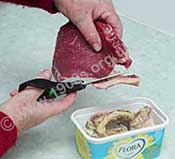
Making off-cuts for dripping by cutting excess fat of braising steak.
Usually I make my off-cuts before cooking but within the family I have been known to add the better-looking leftovers from plates.
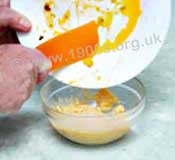
Cooked fat left on a serving plate being added to dripping. The fat in this picture is from lasagna which explains the orange colour which is from tomato.
When ready to make my dripping, I use these off-cuts straight from the freezer by placing them over the raw meat or chicken before it goes into the oven. It isn't necessary to thaw the off-cuts before use as they thaw very quickly in the oven. This renders them down into liquid fat in the cooking pan as well as crisping the outside of the joint. This use of offcuts replaces the foil covering which is usually recommended.
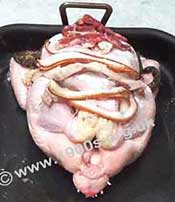
Fatty off-cuts spread on meat before roasting.
The roasted off-cuts give a good flavour to the roast vegetables around meat, but the roast generally needs more fat than the off-cuts can provide. As the extra fat added by most people is normally oil, the residue in the pan is not suitable for dripping, as it will never solidify. Use it instead in the accompanying gravy.
From hot fat to dripping the quick and easy way
The hot fat from the roast can simply be poured off into a basin for short-term use or into a fridge container to go into the freezer for use as required. However it does contain charred bits of meat and other meat juices. Fortunately these sink to the bottom before the fat solidifies, so the top of the dripping can be used as it is and the lower part discarded - either immediately or once frozen.
That's it! But read on if you are a gluton for punishment or are interested in the old way of doing things.
Traditional cleaning of dripping, called clarification
The process of cleaning the fat is called 'clarification' and if you are interested, read on. It must be said though, that it was more worth doing in the past when families were large, beef joints were large and a good amount of clean dripping could be saved by clarification.
I have clarified my dripping a few times in the past, just to experience it, but I seldom bother now, because families are so small that the saving is negligible.
It is done before the fat has set in the pan by adding boiling water. I did this first stage of clarifying while the remains of the roast meat were still in the pan because it helped to clean the pan while also preventing waste.
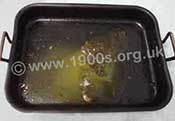
Dirty, messy roasting pan after a roast meal.
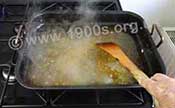
Stirring fat and water in roasting pan to clarify the fat and clean the pan.
I poured boiling water into the pan that the meat was roasted in, still with its messy fatty remains and heated it up again on the hob. As the water boiled, I stirred while scraping the bottom of the pan with a flat wooden spatula. This went a long way towards cleaning the pan for the eventual washing up while loosening as much as possible of the remains of the cooking.
Heatproof dishes have come a long way since the popularity of the glazed china basins in my mother's and grandmother's time. So rather than using a china basin for the clarification, I used a heatproof glass basin. This allowed me to see how much dripping has been produced, how dirty it is and whether extra boiling water is required for clarifying.
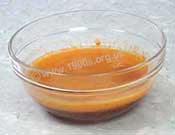
Clarified fat still with the boiled water at the bottom
I poured the boiling contents of the pan into the basin and added more boiling water if it looked necessary. Then I put on a lid like a plate and left to cool. During this time, the water and charred bits sank to the bottom of the basin, leaving on top the clean clarified fat, now proper dripping. Then the basin and its contents either went into the fridge for immediate use or, more usually, into the freezer for later use.
Can you freeze beef dripping?
Beef dripping can be frozen for storage. I use the frozen dripping mainly for basting the potatoes, parsnips and sweet potatoes of a later roast meal. For such cooking purposes it can be used straight from the freezer, although beef dripping for 'bread and dripping' needs to be softened at room temperature first.
I find that a fork is the best tool for gouging out lumps of hard frozen dripping.
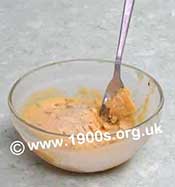
Frozen dripping being gorged out with a fork.
Use of the water from clarification
What may look like dark, dirty water at the bottom of the basin can turn out to be nutritious and flavoursome meat jelly which can be added to sources and gravies.
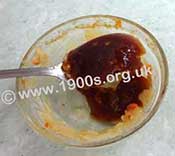
Meat jelly from under the dripping. Note how dark it is, not an indication of burning.
So in general I don't pour off the water/jelly immediately but freeze the dripping in its clarifying bowl with its water/jelly still present. If the 'water' turns out to be floppy jelly, I separate it, remove any bits and use it in gravy or stews. If it is just dirty ice, I simply throw it away.
As an alternative, you can use what is known as a 'gravy separator' for the clarification. The spout is at the bottom of the separator rather than the top as with a normal jug, so, once the fat has settled on top, the dirty water/jelly can be poured away leaving the clarified fat.
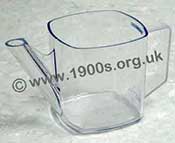
Gravy separator which can also be used for separating rendered fat from meat jelly or clarifying water.
If you can add anything to this page or provide a photo, I would be pleased if you would contact me.
Text and images are copyright
sources: early 20th century material
sources: ww2 home front and other material
contact
the webmaster/author/researcher/editor
privacy policy



